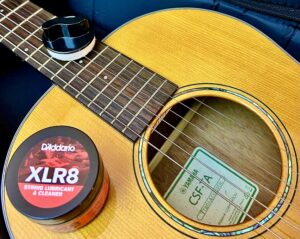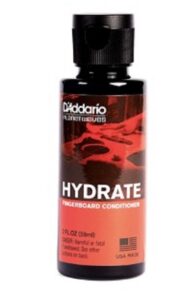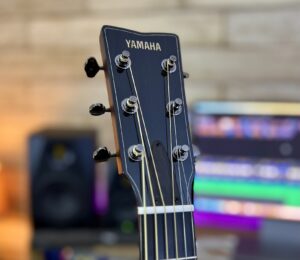Tagged Under:
Guitar Maintenance
Take care of your instrument from the strings, fretboard, finish and more to keep your guitar looking and sounding good.
Anyone who owns a guitar knows how much joy this beautiful and functional work of art can bring to us through music. Learning to play the guitar is not only a serious investment in your development as a musician, but it is also a commitment to take proper care of the instrument itself.
Think of yourself as an artisan whose tools — your instruments — are an extension of the hands that use them. A well-maintained instrument will provide the potential for flawless performances and a lifetime of service, as long as you employ a few regular maintenance checks and guidelines.
If you’re a guitar educator, you are responsible for the health and safety of multiple instruments in your classroom. I’d suggest taking stock of each instrument in the breaks between each school quarter, so that any repairs, string changes and adjustments can be made before classes resume.
Most of the maintenance tips below can be implemented by the instructor, parent or student, however, it’s a good idea to find a local luthier or guitar store for help with detailed repairs or adjustments.

Download this Yamaha Guitar Care Checklist for Students now!
General Care
I always recommend keeping your guitar on a guitar stand that supports the neck of your guitar. A stand with a rubber neck retainer is also useful to prevent the guitar from falling from the cradle. I advocate a guitar being out of its case for a couple of reasons.
You’re more likely to practice if the guitar is visible, and easy to pick up and play, plus the guitar will gradually adjust to the room temperature, and naturally acclimate to its environment. A well-acclimated guitar will generally afford better long-term tuning stability.
Never leave instruments in direct sunlight or near heating sources like radiators. Extreme heat can weaken the glues used in construction, dry out the tone woods, and cause premature color fading of the finishes.
It’s important to note that an extremely dry guitar may start to show signs of cracking along the top, back and sides.
Conversely, a guitar with high levels of moisture content may start to sound less resonant, swell and disfigure, causing glue joints to fail, and protective finishes to lift away from the tone woods. This can leave the guitar permanently damaged, even after repair.

Humidification
Generally speaking, the perfect environment for a guitar is 66-77 °F (19-25 °C) and the ideal humidity levels between 40-50%.
Unless you have a dedicated studio, these ranges are harder to achieve, especially in classroom located in states with extreme weather patterns and seasonal challenges.
The good news is that guitar humidification is available for individual guitars by way of D’Addario Humidipaks. These small humidification bags can be placed in your guitar case or hung inside the guitar sound-hole of an acoustic guitar when it’s not in use.
Humidipaks are two-way humidity-control packs that automatically maintain the ideal humidity level for your guitar.
There are three types of Humidipak.
- Use Humidipak Restore if your instrument is dry and needs additional moisture,
- Use Humidipak Absorb if you are in a high-humidity environment and need to reduce the relative humidity of your instrument.
- Use Humidipak Maintain if you are looking to sustain the proper levels of relative humidity within your instruments.
I recommend putting your guitars in their cases with the appropriate Humidipaks for a couple of days to correct any imbalances. Do this on a regular basis, and you should achieve stable humidity levels within all your instruments.

Strings
String maintenance is critical. I recommend coated strings because they last longer, provide resistance to oil and acidity from the player’s sweat, and prevent premature rusting of the unwound strings.
As strings age, three very important aspects to playability — intonation, tuning stability and clarity — diminish.
Elixir and D’Addario both provide excellent coated strings for acoustic and electric guitars. They may cost a little more than regular strings, but they’ll last five times longer and sound consistently better during that time.

String lubricant and cleaners like the D’Addario XLR8 are excellent for wiping down guitar strings before and after a practice session. They also provide smooth, squeak-free glissandi during position changes along the fretboard.
Keep some on hand at all times.
Classical guitars equipped with nylon strings require regular cleaning, and string changes. Nylon strings won’t rust, but the wound strings (E, A, D) may start to deteriorate after the windings become worn.
Fretboard Care
Fretboard tone-woods, such as rosewood and ebony, can be found on most acoustic, electric and nylon-stringed guitars. These close-grained hardwoods are usually left unfinished and will require moistening with a hydrating oil on a semi-annual basis to prevent them from drying out.
 Many guitar manufacturers recommend lemon oil for this purpose. You can also use D’Addario Hydrate fretboard conditioner.
Many guitar manufacturers recommend lemon oil for this purpose. You can also use D’Addario Hydrate fretboard conditioner.
I recommend applying a small amount of this fretboard conditioner every other time you change strings. Simply apply the conditioning oil with a soft cloth, let it sit for a few minutes and remove any residue. Buff to finish.
Electric guitars with maple fretboards are usually finished with polyurethane or nitrocellulose lacquer. These fretboards can be cleaned with a good quality furniture polish during every string change.
If you use lemon oil to condition your fretboards, avoid making contact with the other finishes, as this may damage them.
Intonation
Ensemble guitar teachers always stress the importance of stable tuning within a classroom environment. There are many factors that contribute to stable tuning, such as perfectly tuned, clean strings; well-installed strings that don’t slip or get caught in the nut; and the intonation of the instrument itself.
New strings can be lightly stretched before use to reduce detuning while being played. Nylon strings will take longer than steel strings to settle in. If a particular string or multiple strings consistently go out of tune, check for a few things.

- Check that the string is seated properly on the saddle and in the correct nut slots. Strings may also get stuck in a poorly cut nut slot, and then release, which detunes the guitar while it’s being played. Have a luthier cut the nut slots cleanly, allowing the strings to pass through them without sticking.
- Make sure the strings have been installed with a suitable winding around the tuning post. I recommend winding the string around the tuning post three times.
- If the nut slots are cut too high, it may cause students to push down too hard on the strings to obtain clean, buzz-free chords. This will make the strings go sharp, especially the B string. Have a luthier re-cut the nut slots so that they are closer to the top of the first fret. Also, check that the overall string action (height of the strings from the fretboard) from the nut to the saddle is playable. Reducing the playing action can dramatically improve a student’s progress and the overall intonation of the instrument.
- Check that the neck relief on each guitar only provides enough “relief” (a tiny concave bow away from the strings) to allow for the strings to resonate without buzzing. You can check this relief by sighting down the fretboard from the nut to the bridge. Hold down the low E string at the first fret and last fret. Sight down to the middle of the string and make sure there’s a small gap between the bottom of the string and the top of the fret wire. The truss rod on your guitar will allow you to reduce or increase the neck relief using a small Allen, or hex, wrench. If you aren’t used to making these adjustments, have the guitar serviced by a professional.
Cleaning the Finish
I clean my guitar finishes every couple of weeks to remove the daily dust, finger grease and sweat that may build up on the surfaces during regular practice sessions. There are many proprietary guitar polishes on the market, but you can also use a good quality wood and furniture polish. Cleaning your guitar will bring you closer to loving it and keep you aware of any other issues or maintenance concerns that may arise.
The Wrap-Up
Modern instruments have usually undergone rigorous checks before they leave the manufacturer, and they may receive more adjustments at the guitar store.
Personal alterations on a per student basis may still need to be made. Keep a keen eye and ear out for student struggles, ensemble tonality, tuning stability, and the overall playing environment in which your guitars reside.
Take the time to assess each guitar on a regular basis, and pair that with some simple routine maintenance checks within the school holidays.
A well-maintained instrument will last a lifetime, and so will the joy and academic benefits of a music education.
Photographs courtesy of Robbie Calvo
Check out Robbie Calvo’s other posts.















